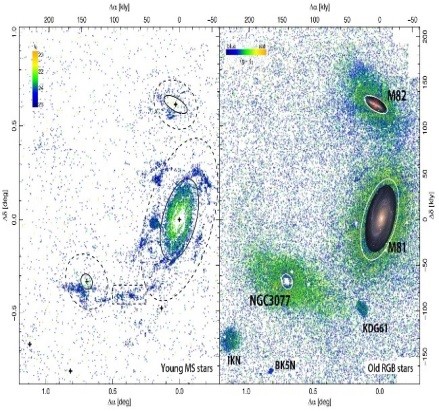A new study led by an astronomer from Shanghai Astronomical Observatory (SHAO) has found evidence revealing a cosmic cannibalizing event --- M81, one of the nearest massive galaxies, is eating two neighboring smaller galaxies and continues to grow. “This is the first endeavor beyond the Local Group of galaxies to demonstrate the hierarchical galaxy assembly process on galactic scales," said team member Dr. Sakurako Okamoto from SHAO. This work has recently been published by the Astrophysical Journal Letters.
When it comes to cosmological galaxy growth, hierarchical structure formation is currently the most favored model. In this model galaxies like our Milky Way (MW) Galaxy and M81 were formed as part of a local over-density in the primordial matter distribution, which is the earliest accumulation of matter in the young universe. Then they grow over time via the agglomeration of numerous smaller building blocks. Some of the smaller building blocks may avoid these mergers to become present-day dwarf satellite galaxies.
Thus, establishing the presence and nature of these satellites, and determining the large-scale structure and stellar content of halos in spiral galaxies, is essential to understand and explain the physics of hierarchical galaxy assembly.
Over the last decade, through large photometric surveys, astronomers have found a number of new satellite galaxies, stellar streams, and over-densities around the MW and the Andromeda galaxies. The detailed properties of stars in these systems have been studied to reconstruct the early stellar content of galaxies, which is called "Galactic Archeology" or "near-field cosmology".
Until now, the outskirts of the Milky Way and Andromeda are the only places that have been surveyed to sufficiently faint depths to enable detailed tests of hierarchical galaxy assembly processes across wide scales. Astronomers still lack similar studies beyond the Local Group. “One reason is that it requires observations with high resolution and wide coverage over a good fraction of the targeted galaxy’s radius.” Said Dr. Okamoto.
Recently, astronomers from Shanghai Astronomical Observatory (SHAO) and other international research institutes used the Subaru Telescope's Hyper Suprime-Cam prime-focus camera (HSC) to observe the nearby large spiral galaxy M81, together with its two brightest neighbors, M82 and NGC 3077.
The exceptionally wide field and high-sensitivity of HSC allowed the team to observe out to a projected radius of a half-million light-years from the center of M81, observing a large number of old red giant branch (RGB) stars as well as young main-sequence (MS) stars, red supergiants, and asymptotic giant-branch stars.

Figure 1: Pseudo-color images from HSC observation which contains M81, M82, and NGC 3077. Diameter of the FOV is 1.5 degrees. Bottom-left: close-up of M81. Bottom-center: further close-up of M81 showing the spiral arm. Bottom-right: color composite of the images used for the analysis. Click to enlarge each frame. (Credit: NAOJ/HSC Project)

Figure 2: Young main-sequence (MS) stars and red-giant branch (RGB) stars around M81, M82, and NGC 3077. Left: yellow are brighter stars, and blue are fainter stars. Right: color-coded for the metallicity, namely yellow is metal rich, blue is metal poor. Solid line shows the R25 radius of the galaxy measured in the visible light. (Credit: NAOJ)
For the young MS stars and core helium-burning stars, they found that bright stars are mainly located in the inner disk of M81, while most of the young stars in outlying concentrations are fainter and their luminosity distribution is similar to the stellar stream between M81 and NGC 3077. As shown in the left panel of Figure 2, it indicates that the ages of stars in these tidal features are synchronized to each other, and that these systems were produced by the recent cannibalizing of M82 and NGC 3077 by M81.
For the RGB stars, they found that the extended stellar halos of the three main galaxies overlap each other, and that the outer regions of M82 and NGC 3077 are highly perturbed. This is likely a consequence of the recent gravitational encounter.
Interestingly, satellite galaxies like KDG 61 and BK5N are not seen in the maps of young stars, but appears as over-densities in the maps of old stars. This implies they are not the product of the recent interaction between M81, M82 and NGC 3077.
Team member Dr. Sakurako Okamoto (Shanghai Astronomical Observatory) commented on this program: "Our deep panoramic view of the M81 group demonstrates that the complexity long known to be present in neutral hydrogen (HI) is equally matched in the low surface brightness stellar component. Together with the Galactic Archeology study based on the HSC wide-field survey of the Subaru Strategic Program, we hope to establish the presence and nature of satellite galaxies, and determine the large-scale structure and stellar content of halos of spiral galaxies in general".
This work has been published in ApJL (http://iopscience.iop.org/article/10.1088/2041-8205/809/1/L1) and is also available on arXiv (http://arxiv.org/abs/1507.04889).
Science contact:
Sakurako Okamoto, Shanghai Astronomical Observatory, okamoto@shao.ac.cn
News contact:
Wenwen Zuo, Shanghai Astronomical Observatory, wenwenzuo@shao.ac.cn